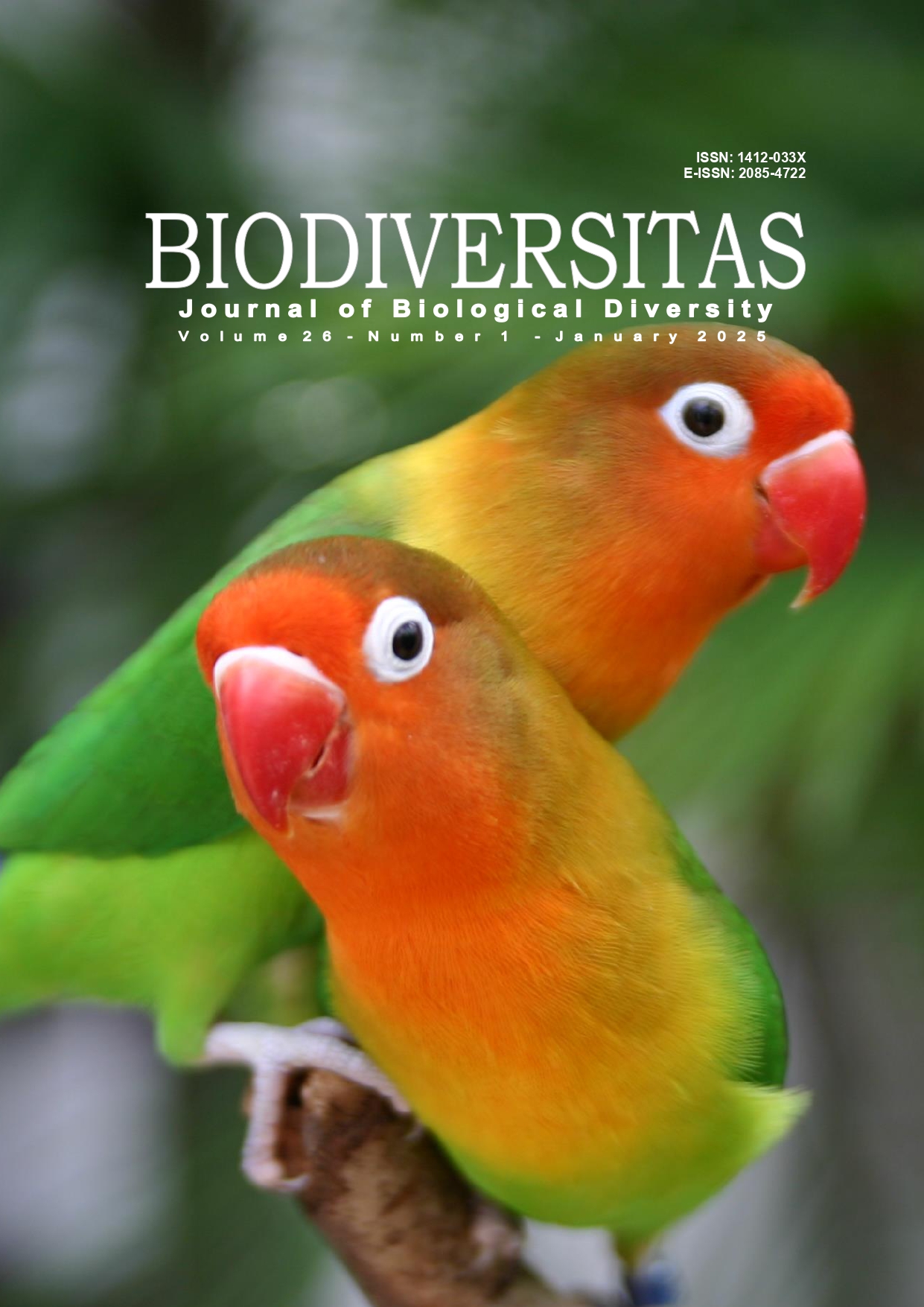Identification of the nettle caterpillar in smallholding oil palm plantation cultivated on peatland in Ogan Ilir, South Sumatra, Indonesia
##plugins.themes.bootstrap3.article.main##
Abstract
Abstract. Anggraini E, Setiawati T, Herlinda S, Irsan C, Mulawarman, Gofar N, Muslim A, Lau WH. 2025. Identification of the nettle caterpillar in smallholding oil palm plantation cultivated on peatland in Ogan Ilir, South Sumatra, Indonesia. Biodiversitas 26: 36-44. Nettle caterpillars are a major pest in oil palm plantations, posing a significant threat to the productivity and sustainability of this crop. These voracious leaf-feeding caterpillars can cause severe damage, hindering plant growth, reducing fruit production, and even leading to the mortality of oil palm trees. This study aimed to identify the species of caterpillars that inflict damage, their physical traits, population densities, and the symptoms of their attacks. This study employed direct observation and documentation of caterpillar species in the field. Observations were conducted to assess the extent of damage inflicted by caterpillars in the field. Subsequently, document using a camera, collect field samples, and identification of the nettle caterpillars found in oil palm plantation cultivated on peatland in Ogan Ilir, South Sumatera, Indonesia. This investigation identified three species of caterpillars: Setora nitens, Birthosea bisura, and Parasa lepida. These three species of caterpillars typically exhibit similar coloration but possess distinct morphological traits. The S. nitens species predominates among the largest number of species. Caterpillars consume both young and mature oil palm leaves, remaining only in the midrib. Additional indications of the attack include perforations in the leaves. The incidence of caterpillar assaults may attain 100% of nettle caterpillar infestation, accompanied by an attack rate of 57.75%. This study concludes that three primary species of nettle caterpillar were identified in oil palm plantations, exhibiting indications of damage classified as fairly severe. Thus, effective management of nettle caterpillars is crucial to maintaining the productivity and profitability of oil palm plantations.
##plugins.themes.bootstrap3.article.details##
Most read articles by the same author(s)
- SITI HERLINDA, NONI OCTARIATI, SUWANDI SUWANDI, HASBI, Exploring entomopathogenic fungi from South Sumatra (Indonesia) soil and their pathogenicity against a new invasive maize pest, Spodoptera frugiperda , Biodiversitas Journal of Biological Diversity: Vol. 21 No. 7 (2020)
- MIMMA GUSTIANINGTYAS, SITI HERLINDA, SUWANDI SUWANDI, The endophytic fungi from South Sumatra (Indonesia) and their pathogenecity against the new invasive fall armyworm, Spodoptera frugiperda , Biodiversitas Journal of Biological Diversity: Vol. 22 No. 2 (2021)
- DWI RIZKI AYUDYA, SITI HERLINDA, SUWANDI SUWANDI, Insecticidal activity of culture filtrates from liquid medium of Beauveria bassiana isolates from South Sumatra (Indonesia) wetland soil against larvae of Spodoptera litura , Biodiversitas Journal of Biological Diversity: Vol. 20 No. 8 (2019)
- SITI HERLINDA, RISKI ANWAR EFENDI, RADIX SUHARJO, HASBI, ARUM SETIAWAN, ELFITA, MARIESKA VERAWATY, New emerging entomopathogenic fungi isolated from soil in South Sumatra (Indonesia) and their filtrate and conidial insecticidal activity against Spodoptera litura , Biodiversitas Journal of Biological Diversity: Vol. 21 No. 11 (2020)
- SITI HERLINDA, GHANNI PRABAWATI, YULIA PUJIASTUTI, SUSILAWATI, TILI KARENINA, HASBI, CHANDRA IRSAN, Herbivore insects and predatory arthropods in freshwater swamp rice field in South Sumatra, Indonesia sprayed with bioinsecticides of entomopathogenic fungi and abamectin , Biodiversitas Journal of Biological Diversity: Vol. 21 No. 8 (2020)
- SITI HERLINDA, TITI TRICAHYATI, CHANDRA IRSAN, TILI KARENINA, HASBI, SUPARMAN, BENYAMIN LAKITAN, ERISE ANGGRAINI, ARSI, Arboreal arthropod assemblages in chili pepper with different mulches and pest managements in freshwater swamps of South Sumatra, Indonesia , Biodiversitas Journal of Biological Diversity: Vol. 22 No. 6 (2021)
- TILI KARENINA, SITI HERLINDA, CHANDRA IRSAN, YULIA PUJIASTUTI, HASBI, SUPARMAN, BENYAMIN LAKITAN, HARMAN HAMIDSON, ABU UMAYAH, Community structure of arboreal and soil-dwelling arthropods in three different rice planting indexes in freshwater swamps of South Sumatra, Indonesia , Biodiversitas Journal of Biological Diversity: Vol. 21 No. 10 (2020)
- KHOIRUL IKHSANUDIN HANIF, SITI HERLINDA, CHANDRA IRSAN, YULIA PUJIASTUTI, GHANNI PRABAWATI, HASBI, TILI KARENINA, The impact of bioinsecticide overdoses of Beauveria bassiana on species diversity and abundance of not targeted arthropods in South Sumatra (Indonesia) freshwater swamp paddy , Biodiversitas Journal of Biological Diversity: Vol. 21 No. 5 (2020)
- ERISE ANGGRAINI, WIDA NUR ANISA, SITI HERLINDA, CHANDRA IRSAN, SUPARMAN SUPARMAN, SUWANDI SUWANDI, MUHAMMAD UMAR HARUN, BAMBANG GUNAWAN, Phytophagous insects and predatory arthropods in soybean and zinnia , Biodiversitas Journal of Biological Diversity: Vol. 22 No. 3 (2021)

